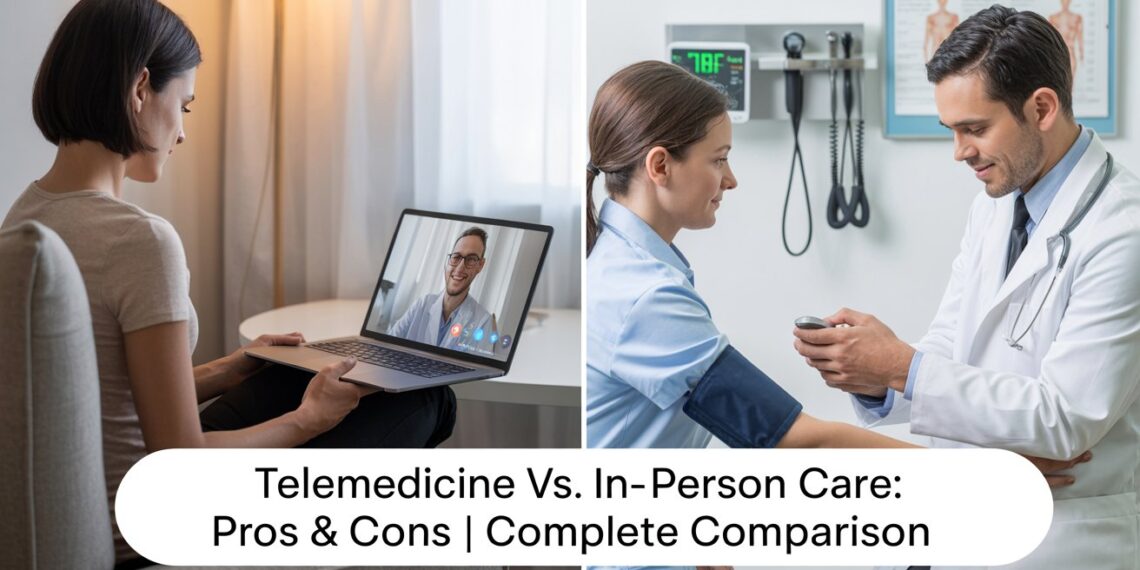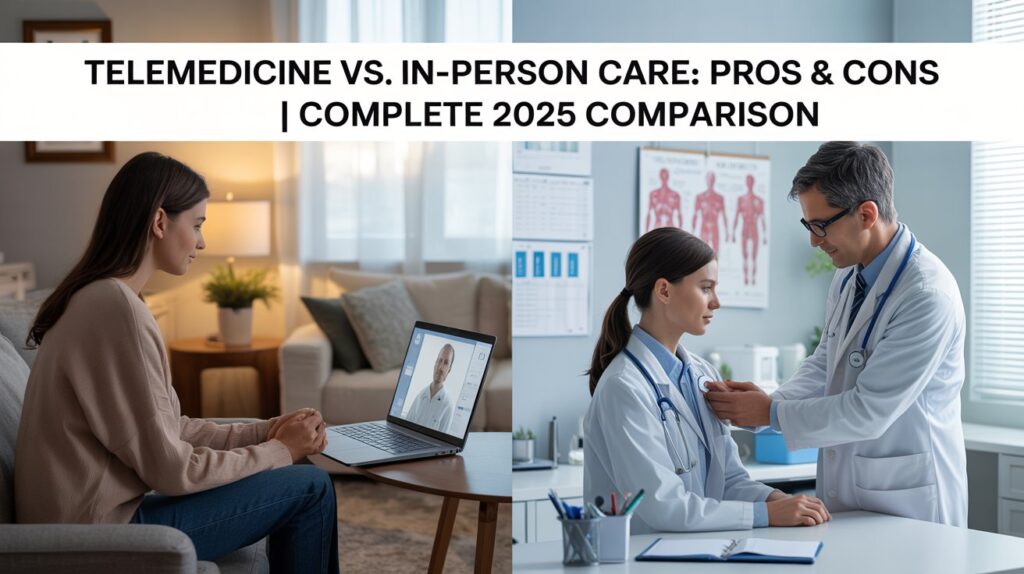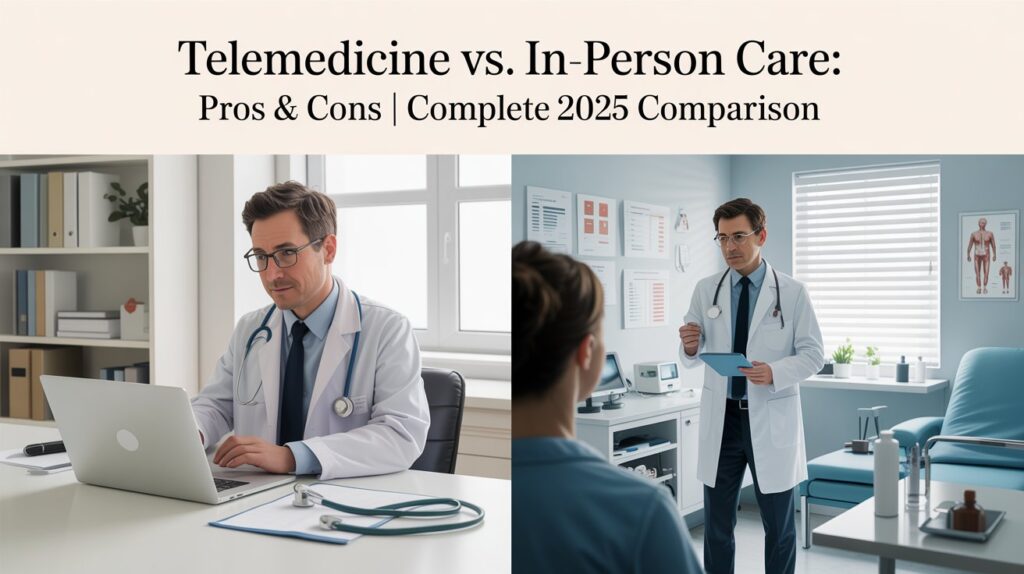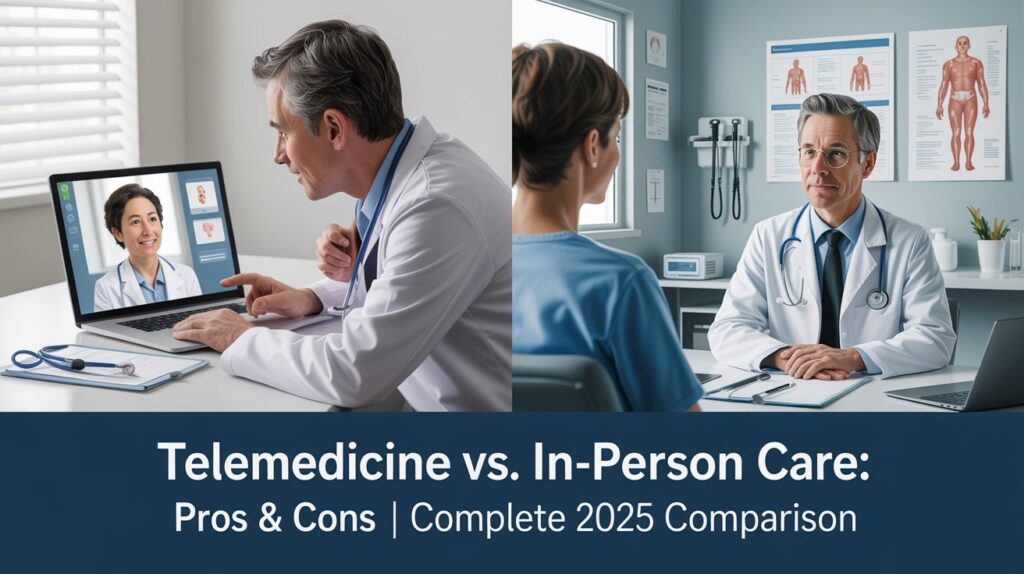Healthcare has undergone a remarkable transformation over the past decade. The traditional image of sitting in a waiting room for an in-person appointment is evolving as digital technology brings medical consultations into our homes. The rise of telemedicine—the remote delivery of healthcare through video calls, phone consultations, and online platforms—has reshaped how patients and doctors connect.
The discussion around Telemedicine vs. In-Person Care: Pros & Cons has become more relevant than ever. Both methods offer distinct benefits and limitations. For many patients and providers, the ideal approach depends on medical needs, convenience, access, and personal preferences.
This article explores the differences between telemedicine and in-person care, highlighting their respective strengths and drawbacks, evidence-based insights, and guidance on when each form of care is most appropriate.
What Is Telemedicine?
Telemedicine refers to the use of telecommunications technology—such as video conferencing, phone calls, and secure messaging—to provide clinical services remotely. It can include virtual consultations, follow-up visits, remote monitoring of chronic diseases, and even electronic prescriptions.
Initially developed to bridge healthcare access gaps for rural or mobility-challenged patients, telemedicine became a mainstream solution during the COVID-19 pandemic. Today, it is an integral part of modern healthcare systems, supported by insurance providers and healthcare networks worldwide.
Common Uses of Telemedicine
-
Routine follow-ups for chronic conditions such as diabetes or hypertension
-
Mental health counseling and therapy sessions
-
Prescription renewals and medication adjustments
-
Minor illnesses (e.g., colds, allergies, skin irritations)
-
Post-operative monitoring and lab result discussions
What Is In-Person Care?
In-person care, the traditional method of medical treatment, involves physically visiting a healthcare facility for diagnosis and management. This setting allows for physical examinations, direct procedures, diagnostic imaging, and laboratory testing that cannot be done remotely.
While telemedicine offers convenience, in-person care remains essential for accurate assessments, emergencies, and complex health issues that require a hands-on approach.
Common Uses of In-Person Care
-
Physical exams and procedures
-
Diagnostic tests (X-rays, MRIs, blood tests)
-
Emergency or urgent care situations
-
Surgical consultations
-
Complex conditions requiring specialist evaluation
Pros of Telemedicine
1. Convenience and Accessibility
Telemedicine eliminates the need for travel, parking, and long waiting room times. Patients can connect with their healthcare provider from anywhere—home, work, or even while traveling. This convenience especially benefits rural residents, seniors, and people with mobility challenges.
2. Cost-Effective Care
Virtual consultations often cost less than in-person visits. Both patients and healthcare systems save on transportation, facility fees, and administrative overhead. For non-emergency cases, telemedicine can significantly reduce healthcare spending.
3. Expanded Access to Specialists
Telemedicine bridges geographical barriers, enabling patients to consult specialists located in other cities or even countries. For rare conditions or subspecialty care, this can lead to faster diagnosis and better outcomes.
4. Lower Risk of Infection
During outbreaks such as COVID-19, remote consultations reduce the risk of exposure to infectious diseases. Patients with chronic illnesses or weakened immune systems can receive care without unnecessary health risks.
5. Efficient Follow-Ups and Monitoring
For patients managing chronic conditions, remote monitoring tools allow doctors to track vital signs, medication adherence, and progress in real-time. This approach improves continuity of care and patient engagement.
Cons of Telemedicine
1. Limited Physical Examination
The primary limitation of telemedicine is the lack of hands-on examination. Many conditions require palpation, auscultation, or diagnostic imaging that cannot be performed through a screen. This limitation can lead to incomplete assessments or delayed diagnoses.
2. Technology and Connectivity Issues
Telemedicine depends on stable internet connections and compatible devices. Patients in areas with poor connectivity may experience dropped calls, lagging video, or difficulty accessing telehealth platforms—compromising care quality.
3. Privacy and Security Concerns
Although most telemedicine platforms use encryption and secure connections, there is always a risk of data breaches. Patients must trust that their medical information is protected under privacy laws such as HIPAA.
4. Not Suitable for Emergencies
In urgent or life-threatening situations—such as chest pain, severe bleeding, or trauma—telemedicine cannot replace immediate, hands-on medical intervention.
5. Potential for Misdiagnosis
Without physical exams, doctors rely heavily on patient-reported symptoms and visual cues. Miscommunication or poor image quality can lead to misdiagnosis, inappropriate prescriptions, or missed conditions.
Pros of In-Person Care
1. Comprehensive Physical Examination
In-person care allows healthcare providers to perform a full physical assessment, order lab tests, and use diagnostic tools immediately. This hands-on approach ensures accuracy and thorough evaluation.
2. Stronger Doctor–Patient Relationship
Face-to-face interaction fosters trust, empathy, and clearer communication. Many patients feel more comfortable discussing sensitive health concerns in person rather than through a screen.
3. Immediate Testing and Treatment
Clinics and hospitals provide access to on-site diagnostics and immediate treatments. From vaccinations to imaging, patients can complete multiple services in a single visit.
4. Better for Complex and Acute Cases
Certain medical conditions—such as cardiac symptoms, fractures, or neurological issues—require in-person evaluation and monitoring. These cannot be accurately managed through telemedicine alone.
5. Reduced Risk of Technical Failure
Unlike virtual platforms, in-person care does not rely on technology or internet connections. This makes it reliable and consistent, especially in critical care scenarios.
Cons of In-Person Care
1. Time and Travel Burden
Visiting a clinic often involves scheduling challenges, travel time, and long waiting periods. For patients living in rural areas, reaching a hospital can take hours.
2. Higher Costs
Facility fees, transportation, and parking add to the overall cost of in-person care. These expenses can be significant for frequent follow-ups or non-urgent consultations.
3. Exposure to Illnesses
In crowded clinics or hospitals, patients may be exposed to infections, particularly during flu season or pandemics.
4. Accessibility Challenges
Patients with disabilities, chronic fatigue, or mobility limitations may find it difficult to attend appointments regularly.
Evidence from Research and Case Studies
Recent research shows that telemedicine delivers comparable results to in-person care for many conditions. Studies published in medical journals have found similar patient satisfaction and clinical outcomes in chronic disease management, mental health, and follow-up care.
However, evidence also indicates that telemedicine visits may lead to higher follow-up rates because some cases still require physical assessment. In contrast, in-person visits result in more diagnostic testing and immediate interventions.
For example, in primary care, telemedicine consultations tend to be shorter but more focused, whereas in-person appointments often include additional services like lab tests and imaging.
Choosing Between Telemedicine and In-Person Care
When to Choose Telemedicine
-
Routine check-ups and chronic disease management
-
Prescription refills and follow-up appointments
-
Minor illnesses such as sore throats, allergies, or rashes
-
Mental health counseling or therapy sessions
-
When travel is difficult or risky
When to Choose In-Person Care
-
New or undiagnosed symptoms that need physical examination
-
Severe or sudden medical conditions
-
Procedures, vaccinations, or lab work
-
Diagnostic imaging or physical therapy sessions
-
When technology or connectivity is unreliable
Hybrid Care: The Best of Both Worlds
Many healthcare systems now offer hybrid care models—combining virtual consultations with scheduled in-person visits. This approach enhances flexibility, ensures thorough evaluation, and maximizes patient satisfaction. For example, a patient may have an initial telemedicine consultation, followed by an in-person diagnostic exam or procedure.
Barriers and Challenges
While telemedicine offers enormous potential, several challenges must be addressed to achieve equity and safety:
-
Regulatory and Licensing Issues: Cross-state or cross-border telemedicine requires unified regulations to ensure consistent care standards.
-
Reimbursement Policies: Insurance coverage for telemedicine varies by country and provider.
-
Digital Divide: Low-income and elderly populations may lack the necessary technology or internet access.
-
Training and Infrastructure: Healthcare providers must adapt to digital platforms and integrate them into existing workflows.
Future of Healthcare: A Blended Approach
The future of healthcare is neither purely virtual nor exclusively in-person—it’s hybrid. Advances in wearable technology, artificial intelligence, and remote monitoring tools will continue to expand the capabilities of telemedicine.
However, physical examinations, empathy-driven interactions, and certain diagnostic processes will always require human presence. The most successful healthcare systems will integrate both models, using telemedicine for efficiency and in-person care for precision.
FAQs
1. Is telemedicine as effective as in-person care?
For many non-emergency and chronic conditions, telemedicine provides comparable effectiveness and patient satisfaction. However, it cannot replace the diagnostic accuracy of in-person evaluations in complex or urgent cases.
2. Are telemedicine consultations covered by insurance?
Most insurance providers now cover telemedicine visits, especially after the pandemic. Coverage varies depending on the plan and region, so patients should verify with their insurer.
3. What types of conditions are best managed through telemedicine?
Telemedicine works best for routine follow-ups, chronic disease management, minor infections, and mental health services.
4. Can telemedicine replace physical exams completely?
No. Physical exams and diagnostic procedures remain essential for many health conditions. Telemedicine should complement, not replace, traditional care.
5. What are the main risks of telemedicine?
Potential risks include data privacy breaches, misdiagnosis due to limited examination, and unequal access for those lacking technology or internet connectivity.
Conclusion
The debate between Telemedicine vs. In-Person Care: Pros & Cons is not about choosing one over the other—it’s about balance. Telemedicine offers unmatched convenience, cost savings, and accessibility, making it ideal for follow-ups and non-urgent care. Meanwhile, in-person visits remain critical for accurate diagnoses, complex treatments, and emergencies.
The future of healthcare lies in blending both methods to create a flexible, patient-centered system. By understanding the strengths and limitations of each, patients and providers can make informed choices that ensure safety, efficiency, and high-quality care.











